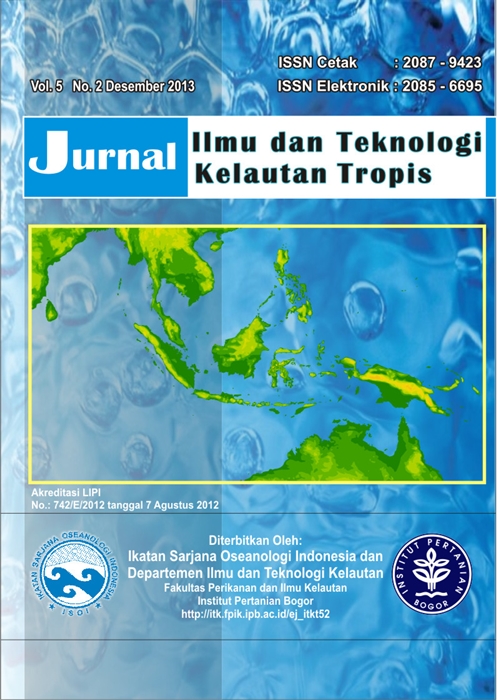VARIABILITY AND SPATIAL DISTRIBUTION OF TOTAL SCATTERING COEFFICIENTS OF SURFACE WATER IN VARIOUS SEASONS
Abstract
Variability and spatial distribution data of the total scattering coefficients ares useful in the development of bio-optical algorithms of ocean color satellite. The purpose of this study was to determine the variability and spatial distribution of the total scattering coefficient at 9 wavelengths (λ) in different seasons. Field data collection were conducted in the Northeastern Gulf of Mexico (NEGOM) of the spring , summer, and fall in 1999-2000 by using the ac-9 in-situ Spectrophotometer and restricted to coastal waters of 10 m isobath and offshore of 1000 m isobath. The data were filtered using the moving average method and tested with the Kruskal-Wallis. The results showed that the average value of the total scattering coefficients were significantly different among spring, summer, and fall. In general, the total scattering coefficients were relatively high, especially in the coastal waters near the mouth of the river each season and relatively low in offshore waters except during the summer that the total scattering coefficients were also relatively high in offshore watersdue to the intrusion of the Mississippi river flow toward offshore containing high nutrients that can promote the growth of phytoplankton in the offshore, suspended material and lower salinity jointly to increase the total scattering coefficients.
Keywords: variability, spatial distribution, total scattering coefficient, bio-optic, NEGOM.
Authors
This work is licensed under a Creative Commons Attribution 4.0 International License.
Jurnal Ilmu dan Teknologi Kelautan Tropis i is an open-access journal, meaning that all content is freely available without charge to the user or their institution. Users are allowed to read, download, copy, distribute, print, search, or link to the full texts of the articles in this journal without needing to request prior permission from the publisher or the author.
All articles published by Jurnal Ilmu dan Teknologi Kelautan Tropis are licensed under the Creative Commons Attribution 4.0 International License. This allows for unrestricted use, distribution, and reproduction in any medium, provided proper credit is given to the original authors.
Authors submitting manuscripts should understand and agree that the copyright of published manuscripts is retained by the authors. Copyright encompasses the exclusive rights of authors to reproduce, distribute, and sell any part of the journal articles in all forms and media. Reproduction of any part of this journal, its storage in databases, and its transmission by any form or media is allowed without written permission from Jurnal Ilmu dan Teknologi Kelautan Tropis.


